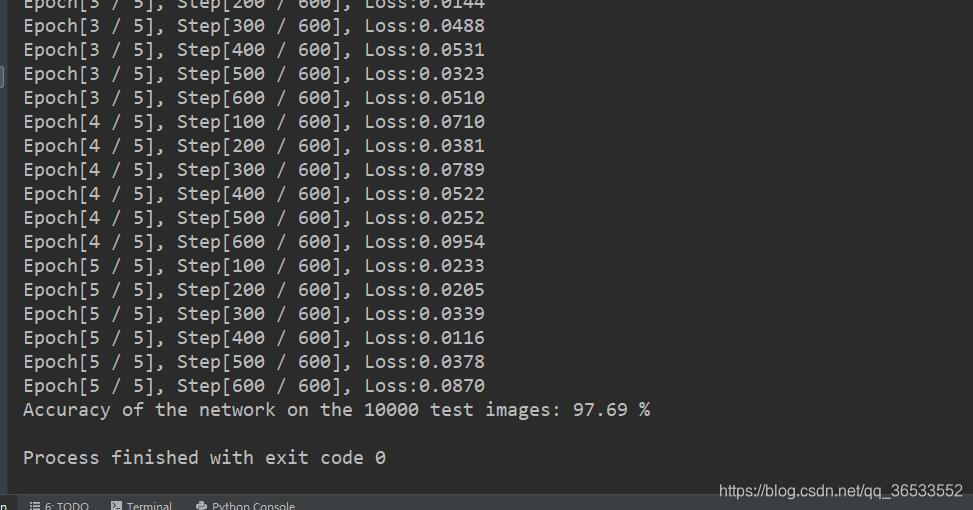import torch
import torch.nn as nn
import torchvision
import torchvision.transforms as transforms
# Device configuration; torch.device代表将torch.Tensor分配到的设备的对象。
device = torch.device('cuda'if torch.cuda.is_available() else 'cpu')
# Hyper-parameters
input_size = 784
hidden_size = 500
num_classes = 10
num_epochs = 5
batch_size = 100
learning_rate = 0.001
# MNIST dataset
train_dataset = torchvision.datasets.MNIST(root='../data', train=True, transform=transforms.ToTensor(), download=True)
test_dataset = torchvision.datasets.MNIST(root='../data', train=False, transform=transforms.ToTensor())
# Data loader
train_loader = torch.utils.data.DataLoader(dataset=train_dataset, batch_size=batch_size, shuffle=True)
test_loader = torch.utils.data.DataLoader(dataset=test_dataset, batch_size=batch_size, shuffle=False)
# Fully connected neural network with one hidden layer 定义自己模型
class NeuralNet(nn.Module):
def __init__(self, input_size, hiddlen_size, num_classes):
super(NeuralNet, self).__init__()
self.fc1 = nn.Linear(input_size, hidden_size)
self.relu = nn.ReLU()
self.fc2 = nn.Linear(hidden_size, num_classes)
def forward(self, x):
out = self.fc1(x)
out = self.relu(out)
out = self.fc2(out)
return out
model = NeuralNet(input_size, hidden_size, num_classes).to(device)
# Loss and optimizer
criterion = nn.CrossEntropyLoss()
optimizer = torch.optim.Adam(model.parameters(), lr=learning_rate)
# Train the model
total_step = len(train_loader)
for epoch in range(num_epochs):
for i, (images, labels) in enumerate(train_loader):
# Move tensors to the configured device
images = images.reshape(-1,28 * 28).to(device)
labels = labels.to(device) #???
# Forward pass
outputs = model(images)
loss = criterion(outputs, labels)
# Backward and optimize
optimizer.zero_grad()
loss.backward()
optimizer.step()
if (i+1) % 100 == 0:
print('Epoch[{} / {}], Step[{} / {}], Loss:{:.4f}'.format(epoch+1, num_epochs, i+1, total_step, loss.item()))
# Test the model
# In test phase, we don't need to compute gradients (for memory efficiency)
with torch.no_grad():
correct = 0
total = 0
for images, labels in test_loader:
images = images.reshape(-1, 28*28).to(device)
labels = labels.to(device)
outputs = model(images)
_, predicted = torch.max(outputs.data, 1)
total += labels.size(0)
correct += (predicted == labels).sum().item()
print('Accuracy of the network on the 10000 test images: {} %'.format(100 * correct / total))
# Save the model checkpoint
torch.save(model.state_dict(), 'model.ckpt')







 本文介绍了一个使用PyTorch框架搭建的简单全连接神经网络模型,并在MNIST手写数字数据集上进行训练和测试的过程。模型包含一个隐藏层,采用ReLU激活函数,并使用Adam优化器及交叉熵损失函数来更新参数。
本文介绍了一个使用PyTorch框架搭建的简单全连接神经网络模型,并在MNIST手写数字数据集上进行训练和测试的过程。模型包含一个隐藏层,采用ReLU激活函数,并使用Adam优化器及交叉熵损失函数来更新参数。
















 3130
3130

 被折叠的 条评论
为什么被折叠?
被折叠的 条评论
为什么被折叠?








